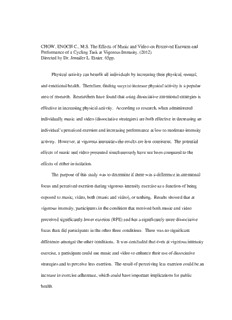
The effects of music and video on perceived exertion and PDF
Preview The effects of music and video on perceived exertion and
CHOW, ENOCH C., M.S. The Effects of Music and Video on Perceived Exertion and Performance of a Cycling Task at Vigorous Intensity. (2012) Directed by Dr. Jennifer L. Etnier. 65pp. Physical activity can benefit all individuals by increasing their physical, mental, and emotional health. Therefore, finding ways to increase physical activity is a popular area of research. Researchers have found that using dissociative attentional strategies is effective in increasing physical activity. According to research, when administered individually music and video (dissociative strategies) are both effective in decreasing an individual’s perceived exertion and increasing performance at low to moderate intensity activity. However, at vigorous intensities the results are less consistent. The potential effects of music and video presented simultaneously have not been compared to the effects of either in isolation. The purpose of this study was to determine if there was a difference in attentional focus and perceived exertion during vigorous intensity exercise as a function of being exposed to music, video, both (music and video), or nothing. Results showed that at vigorous intensity, participants in the condition that received both music and video perceived significantly lower exertion (RPE) and has a significantly more dissociative focus than did participants in the other three conditions. There was no significant difference amongst the other conditions. It was concluded that even at vigorous intensity exercise, a participant could use music and video to enhance their use of dissociative strategies and to perceive less exertion. The result of perceiving less exertion could be an increase in exercise adherence, which could have important implications for public health. THE EFFECTS OF MUSIC AND VIDEO ON PERCEIVED EXERTION AND PERFORMANCE OF A CYCLING TASK AT VIGOROUS INTENSITY by Enoch C. Chow A Thesis Submitted to the Faculty of The Graduate School at The University of North Carolina at Greensboro in Partial Fulfillment of the Requirements for the Degree Master of Science Greensboro 2012 Approved by _________________________________ Committee Chair To Dad and Mom ii APPROVAL PAGE This thesis has been approved by the following committee of the Faculty of The Graduate School at The University of North Carolina at Greensboro Committee Chair _________________________________ Committee Members __________________________________ __________________________________ __________________________________ ____________________________ Date of Acceptance by Committee ____________________________ Date of Final Oral Examination iii ACKNOWLEDGEMENTS I would like to acknowledge my mentor and committee chair Dr. Jennifer Etnier. I would also like to acknowledge Dr. Laurie Wideman and Dr. Wally Bixby for being on my thesis committee. I would like to acknowledge DJ Oberlin for aiding my research study. Finally, I would like to acknowledge the Theodore-Loretta Williams Graduate Research Award for the Arts and Dr. Kathy Williams for the financial support that made my master’s study possible. iv TABLE OF CONTENTS Page LIST OF TABLES ............................................................................................................ vii LIST OF FIGURES ......................................................................................................... viii CHAPTER I. INTRODUCTION .................................................................................................1 Purpose/Research Question .........................................................................7 Hypothesis....................................................................................................7 II. EXTENDED LITERATURE REVIEW ................................................................8 Attention ......................................................................................................8 Research With Music .................................................................................14 Research With Video .................................................................................20 III. METHODS ..........................................................................................................26 Participants .................................................................................................26 Materials and Measures .............................................................................27 Procedures ..................................................................................................31 Compensation ............................................................................................34 Analysis (Repeated Measures Two-Way ANOVA) ..................................34 IV. RESULTS ............................................................................................................36 Ratings of Perceived Exertion ...................................................................36 Work Rate ..................................................................................................37 Heart Rate ..................................................................................................38 Attentional Focus .......................................................................................39 Feeling Scale ..............................................................................................40 Felt Arousal Scale ......................................................................................42 Lactate ........................................................................................................43 V. DISCUSSION ......................................................................................................49 VI. CONCLUSION ....................................................................................................53 v REFERENCES ..................................................................................................................54 APPENDIX A. AHA/ACSM HEALTH/FITNESS FACILITY PRE-PARTICIPATION SCREENING QUESTIONNAIRE ............58 APPENDIX B. DEMOGRAPHICS ..................................................................................60 APPENDIX C. BORG RPE SCALE .................................................................................62 APPENDIX D. ATTENTION SCALE..............................................................................63 APPENDIX E. FEELING SCALE ....................................................................................64 APPENDIX F. FELT AROUSAL SCALE .......................................................................65 vi LIST OF TABLES Page Table 1. Descriptive Information for all Participants ........................................................44 Table 2. Lactate of Participants (mmol/L) (VO Max Session) .........................................44 2 Table 3. Lactate of Participants (Experimental Sessions) .................................................45 Table 4. Participant VO Max Session Data (Maximum Values Observed) .....................45 2 Table 5. Ventilatory Threshold and VO Max Data ..........................................................46 2 Table 6. Descriptive Data Collapsed Across Time for each Experimental Condition (Mean, M, and Standard Error, SE) .................................................46 Table 7. Descriptive Data for the Condition x Time Interaction (Mean, M, and Standard Error, SE) ..................................................................47 vii LIST OF FIGURES Page Figure 1. Estimated Marginal Means of RPE ....................................................................37 Figure 2. Estimated Marginal Means of Work Rate ..........................................................38 Figure 3. Estimated Marginal Means of Heart Rate ..........................................................39 Figure 4. Estimated Marginal Means of Attentional Focus ...............................................40 Figure 5. Estimated Marginal Means of Feeling Scale ......................................................41 Figure 6. Estimated Marginal Means of Felt Arousal ........................................................42 Figure 7. Estimated Marginal Means of Lactate ................................................................43 viii CHAPTER I INTRODUCTION Research has shown that physical activity can benefit all individuals by improving their physical, mental, and emotional health (Annesi, 2001). However, within our society today, physical inactivity is widespread and has contributed to the increase in rates of obesity and chronic diseases (Murrock & Higgins, 2009). Identifying ways to limit inactivity, motivate individuals to become physically active, or encourage exercisers to continue their positive physical activity behaviors has developed into a popular subject of research. Research for promotion of physical activity has ranged from studying behavior change (Marshall & Biddle, 2001), to environmental changes (De Cocker, Bourdeaudhuij, Brown, & Cardon, 2007), using electronic reminders (Dunton & Robertson, 2008; Fjeldsoe, Miller, & Marshall, 2010), and considering ways to control attention (Razon, Basevitch, Land, Thompson, & Tenenbaum, 2009; Lind, Welch, and Ekkekakis, 2009). Many of the aforementioned research areas target physical activity promotion by only introducing strategies to change behavior. Though these strategies may be useful in promoting physical activity, the research on attention has the potential to be even more useful because it also incorporates how an individual feels during physical activity. Research on attention shows that factors such as music and video entertainment can influence attention in a way that ultimately results in a change in 1
Description: